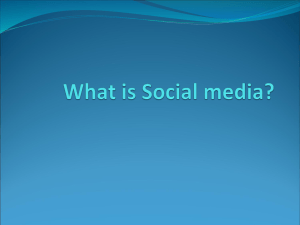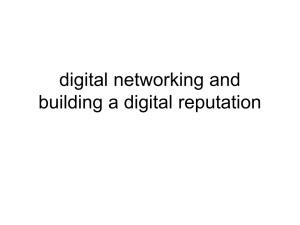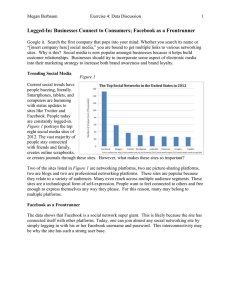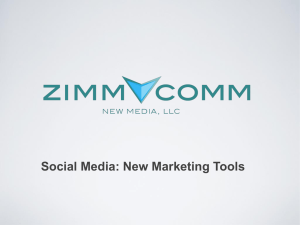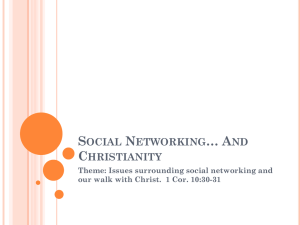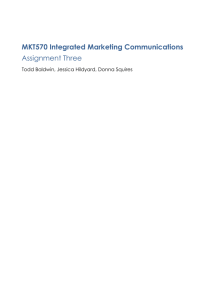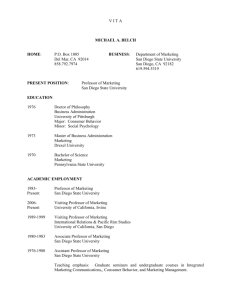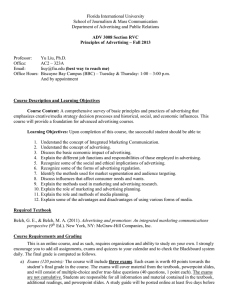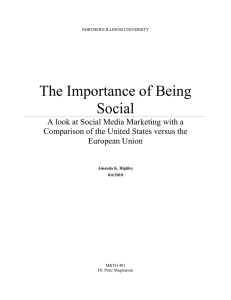Journal of Internet Banking and Commerce
advertisement
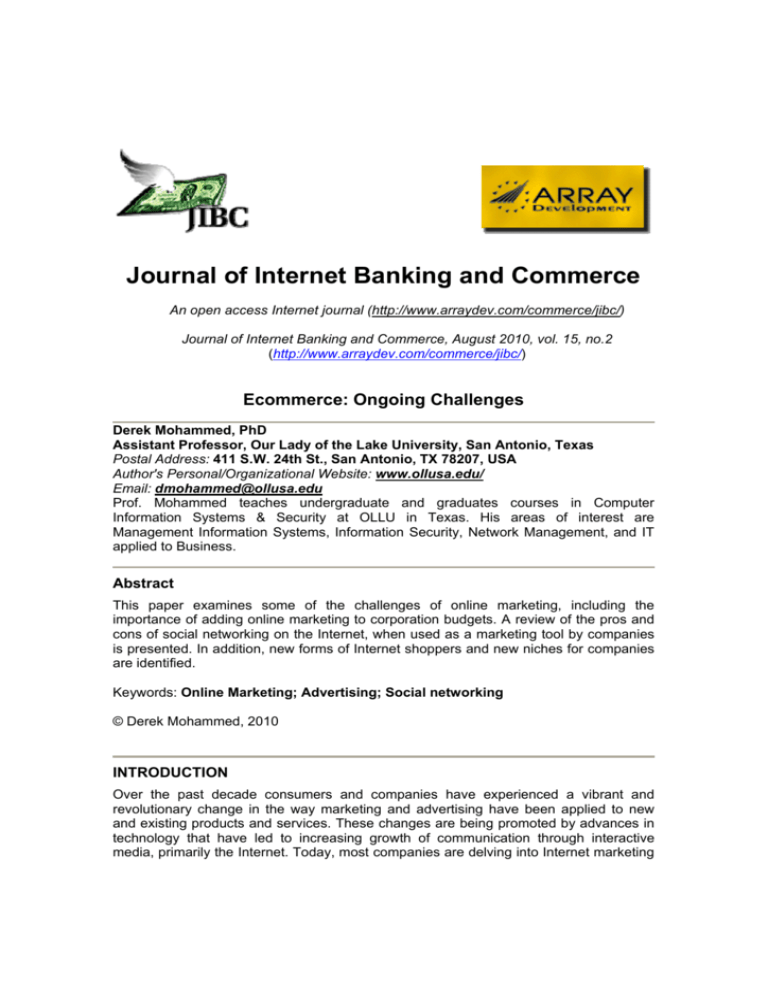
Journal of Internet Banking and Commerce An open access Internet journal (http://www.arraydev.com/commerce/jibc/) Journal of Internet Banking and Commerce, August 2010, vol. 15, no.2 (http://www.arraydev.com/commerce/jibc/) Ecommerce: Ongoing Challenges Derek Mohammed, PhD Assistant Professor, Our Lady of the Lake University, San Antonio, Texas Postal Address: 411 S.W. 24th St., San Antonio, TX 78207, USA Author's Personal/Organizational Website: www.ollusa.edu/ Email: dmohammed@ollusa.edu Prof. Mohammed teaches undergraduate and graduates courses in Computer Information Systems & Security at OLLU in Texas. His areas of interest are Management Information Systems, Information Security, Network Management, and IT applied to Business. Abstract This paper examines some of the challenges of online marketing, including the importance of adding online marketing to corporation budgets. A review of the pros and cons of social networking on the Internet, when used as a marketing tool by companies is presented. In addition, new forms of Internet shoppers and new niches for companies are identified. Keywords: Online Marketing; Advertising; Social networking © Derek Mohammed, 2010 INTRODUCTION Over the past decade consumers and companies have experienced a vibrant and revolutionary change in the way marketing and advertising have been applied to new and existing products and services. These changes are being promoted by advances in technology that have led to increasing growth of communication through interactive media, primarily the Internet. Today, most companies are delving into Internet marketing JIBC August 2010, Vol. 15, No.2 -2- to reach, capture and keep consumers returning to increase brand loyalty and build relationships with their customers. This paper will discuss some key advantages and disadvantages of online marketing. INTERNET MARKETING Burrett (2008) states online marketing is about “carefully targeting users and getting them to interact with you while they’re engaged with the most personal, intimate medium ever invented” (p. 44). Unlike a traditional media audience, internet users have control of their medium. They decide where they want to navigate, what they want to do and which links they want to click. Belch and Belch (2009) stated that one major advantage of online marketing is the Internet allows for a back and forth of information, which gives users the ability to modify the form and content of the information they receive in real time. Another advantage of online marketing is that people are spending more time on their computer. People look at what is available on the Internet, and research prices, stores, and ratings. Then they choose which product or service is best for them. According to Haver (2008) “Today’s younger, more ‘green’ shoppers aren’t going to waste precious money and gas going from store to store looking for just the right item. They shop online whenever they can, narrowing their choices to one or two items-then go to the store to touch, feel, bounce and check out the actual product to see if it looks the way it was represented online.” (p. 2). Therefore it is imperative for companies to create and maintain a useful and attractive website. Burnett (2008) claims a company’s website is not just a brochure or a print ad online rather it’s a destination that users have to tolerate, hence attention to detail is paramount. One of the key advantages of online marketing is no geographical limitation on potential customers. People can discover products and services across the globe. Some websites are created not so much to sell, but to attract customers and utilize a company’s expertise. In fact, having someone like your online marketing campaign so much that they pass it on to family and friends is the jackpot of online marketing. While the internet is a highly affective medium, it also has its disadvantages. One of the greatest disadvantages of the Internet is the lack of measurability of the numbers generated. If one examines the statistics offered by researchers, there is a lack of reliability and validity among the numbers. In fact, McMains (2007) also concluded that the absence of meaningful metrics is a key issue that trouble many marketers. Other obstacles that prevent companies from spending more money on online marketing includes: difficulty of convincing management; limited reach of digital tools; and insufficient capabilities. Annoyance is another factor, for many people, downloading files and information from the Internet takes a long time. Some users have left websites because additional software was needed or the navigation was too difficult. Clutter is another drawback to online marketing. Some sites are bombarded with advertisements, and as a result, many get unnoticed. Many users simply get irritate by the number of pop-ups, and navigate to another website. The Internet has met resistance on the consumer side as well. For instance, today, many companies offer online billing, where invoices come to customers by email, but JIBC August 2010, Vol. 15, No.2 -3- only a few customers take advantage of this convenience. One of the best examples of this resistance was experienced by a U.S. utility company, OECO Energy. Since 1988 the company sent out over 17 million bills, yet only 7,500 customers adopted its e-billing service. According to Carroll (2002) the main reason for this rest in the concept of change, humans are naturally slow to change, and even slower when technology is involved. Online marketing employs a variety of forms, including: banners, sponsorship, pop- ups, push technologies, links, paid searches, interactive media, e-commerce, online magazines and newspapers, social networks, user generated videos such as YouTube, and blogs. In this Internet powered age, where customers have more choices than ever, offering good products is not enough. Atkins (2003) stated “Today’s Web customers are more sophisticated and demanding about their purchase options. They prefer to do business with companies in their own way, 24 hours a day, seven days a week. They want every transaction to be as efficient as possible and unfailing in its accuracy.” (p. 13). Through e-commerce and new technologies for information capture and analysis, companies have the ability to track what customers prefer and need based on purchase history, online habits, click history and other information. Combining e-commerce with customer intelligence makes online marketing practical. Many companies are opting to build interactive communities on their websites, whether for customers, their own employees, or both. Some of these communities or social networks, allow marketers to learn how consumers feel about a brand, and what they would change about a product. In a social network, there are some people who join to grab information, others like to distribute material to others, some just want to simply look around and others want to shape the activity of the group. According to Voight (2007) this type of interaction “can lead to new products and inspire new positioning and inform marketing programs.” (p.15). Therefore it is important for marketers to get on the band wagon of innovative social networking sites, online communities and blogs. Other social networking sites such as Facebook and MySpace are other forms of online marketing. Consumers can learn of new products, share experiences, get excited about new products or vent about negative experiences. This could be an advantage or disadvantaged to any company. For example, the Target Corporation had a positive experience when it created a profile on Facebook. Target’s position as a hip, cool brand for the masses, and strong brand identity with younger consumers helped launch their 2007 back to school campaign on its Facebook page. Target knew who and where their audience was and went after it through online marketing. As a result, Target’s Facebook page was given a theme of ‘Dorm Survival guide.’ Target covered the nuts and bolts of freshman’s jitters, and gave advice on a broad range of issues, from furniture to cooking recipes. They also had an open discussion board where students were free to post comments. This pilot was a huge success for Target since it experimented in unknown waters, social networking sites. On the other hand, Wal-Mart was not so fortunate. WalMart created a back to school Facebook page ‘Roommate Style Match' which was launched from August 2007 to October 2007. Wal-Mart goal was to connect college student with a variety of dorm related products and information. The company’s page did implement a discussion board, but instead, restricted comments by students. Unfortunately, people posted comments about the company’s labor practices, and bloggers took the website to task. Companies need to brainstorm, develop, and critique JIBC August 2010, Vol. 15, No.2 -4- their marketing campaigns before posting then on the Internet, Target and Wal-Mart are prime examples. Social networking on the Internet can spread like wildfire, and the world will have access and form an opinion in a matter of seconds. CONCLUSION Over the past decade many new, innovative and creative forms of marketing have been developed to keep up with our always-changing world. The growth of new technologies has spurred several online marketing avenues including: online communities, ecommerce, social networks, blogs, interactive media, online banners, pop-ups, and user generated videos such as YouTube. It is imperative for all companies, small and large, to keep up with new technologies and interactive forms of marketing to discover target markets and niches, in consumers’ vast options of brands, products and services. REFERENCES Atkins, D. (2003). Use the Net to network, focus sales. Selling, 22(6), 12-13. Belch, G.E., & Belch, M.A. (2009). Advertising and Promotion: An Integrated Marketing Communications Perspective. (8th ed.). Boston: McGraw Hill. Burrett, T. (2008). Market online. B & T Magazine, 58(2682), 44-45. Carroll, L. (2002). The People vs the Interent. Profit, 21(3), 12-13. Haver, K. (2008). Why be on the Internet? Furniture today, 33(17), 2-3. McMains, A. (2007). Why clients withhold AD spending online. Adweek 48(33), 6-7. Voight, J. (2007). Social Marketing Do’s and Don’ts. Adweek, 48(36), 14-30.

